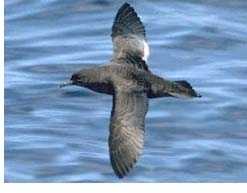Jaimie Cleeland (Institute for Marine and Antarctic Studies, University of Tasmania, Hobart, Australia) and colleagues write in the Journal of Experimental Marine Biology and Ecology on foraging patterns of breeding Short-tailed Shearwaters Puffinus tenuirostris.
The paper’s abstract follows
“During the breeding season, seabirds act as central place foragers, constrained to foraging locations nearer to the breeding colony. Variability in energetic demands during phases of the breeding period has the capacity to shape foraging behaviour and influence at-sea foraging behaviour of seabirds due to the changing requirements of the young. Short-tailed shearwaters (Puffinus tenuirostris) (STSH) are a migratory species that migrates between foraging grounds in the northern Pacific Ocean and breeding colonies in south-east Australia. They are known to traverse large sectors of the Southern Ocean to find prey; however the at-sea foraging locations of this species are not spatially and temporally well defined during the breeding season, when energetic requirements are at their peak. We aimed to define key foraging areas of STSH over the pre-laying, incubation and chick-rearing phases of the breeding cycle and identify associations with broad scale oceanographic features. Using light-level geolocation archival tag technology, 27 adults from a southern Tasmanian colony were tracked from their arrival in October to March (2010–2011), providing information on a total of 77 pre-laying exodus, incubation and chick-rearing flights throughout the Southern Ocean. During the pre-laying exodus and incubation phases, the birds visited waters of the sub-Antarctic Front and Polar Frontal Zone. After hatching, the birds made direct flights to the Marginal Ice Zone between 155°E and 90°E. The Antarctic pack ice is a key nursery ground for Antarctic krill (Euphasia [sic] superba) over the winter months, and as the ice retreats they become more accessible to STSH when energetic demands, due to chick provisioning, are at their greatest. During late chick-rearing, the birds used waters in the region of the Antarctic Divergence. A foraging index created from activity data collected by the tags indicated that adults spent the greatest amount of time foraging at the furthest extent of each trip. This study has shown that STSH alter their foraging movements over the course of the breeding season, using areas that are likely to provide predictable food resources.”

Short-tailed Shearwater at sea, photograph by Mark Carey
Reference:
Cleeland, J.B., Lea, M.-A. & Hindell, M.A. 2014. Use of the Southern Ocean by breeding Short-tailed shearwaters (Puffinus tenuirostris). Journal of Experimental Marine Biology and Ecology 450: 109–117.
John Cooper, ACP Information Officer, 19 December 2013

 English
English  Français
Français  Español
Español